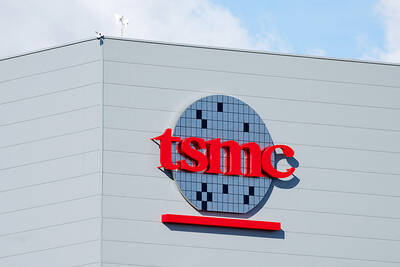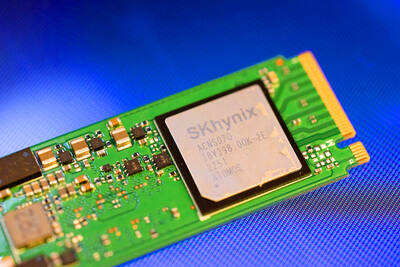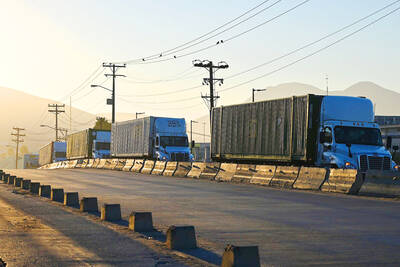Jin Kawaguchiya gave up a career in finance to help revive Japan’s ailing dairy industry — one robot at a time.
In a country that relies increasingly on imported foods like cheese and butter, Japan’s milk output tumbled over two decades, touching a 30-year low in 2014. Costs rose faster than prices as the economy stagnated, eroding profit, and aging farmers quit the business, because they could not find enough young people willing to take on the hard labor of tending to cows every day.
However, technology is altering that dynamic. On the northern island of Hokkaido, Japan’s top dairy-producing region, Kawaguchiya transformed the 20-cow farm he inherited from his father-in-law 16 years ago into Asia’s largest automated milking factory.

Photo: Bloomberg
Robots extract the white fluid from 360 cows three times a day and make sure the animals are fed and healthy. The machines even gather up poop and deposit it in a furnace that generates electricity.
“Without robots, I would have to hire as many as 15 part-time workers to take care of cows,” Kawaguchiya, 44, said during an interview at the dairy in Kakuyama. “I can save ¥15 million [US$146,526] a year thanks to them.”
Kawaguchiya had no experience in farming before taking over the farm from his father-in-law, whose three daughters were not interested in running a dairy that required them to manually attach milking tubes to the teats of each cows.
Kawaguchiya said he quit a job as a manager in Tokyo for Shoko Fund & Co, a business lender, because he saw an opportunity to make a better living in agriculture, provided he could change the economics.
To add scale, he merged the farm with four nearby dairies to create Kalm Kakuyama, a stock company that now has 610 animals, including 380 cows purchased last year. About 250 are calves or pregnant females who are not producing milk for the dairy.
Automation has transformed the business.
After investing ¥1.5 billion to install the robots and a 150 kilowatt-hour generator about 14 months ago, Kawaguchiya said his raw milk production is to quadruple this year from last year to 4,500 tonnes, and reach 5,600 tonnes next year, almost 10 times the output of the average dairy farm in Japan.
He is now the largest producer in western Hokkaido. With less time spent on manual labor, he can analyze data on milk output, quality and animal health to be more efficient.
Kawaguchiya is not alone. The island has more than 100 milking robots, according to Shinichi Otsuka, the head of the agricultural technology department at the Hokkaido Prefecture government.
With bigger and more efficient dairies emerging in Hokkaido, raw milk output is recovering.
In the first half of this year, production in Japan rose 1.1 percent from a year earlier to 3.78 million tonnes, heading for a second annual gain since touching 7.33 million tonnes in 2014, the lowest since 1984, according to the Japanese Ministry of Agriculture, Forestry and Fisheries.
While the number of dairies continues to drop, the ones that remain are getting bigger and productivity per cow is increasing, the data showed.
“So-called ‘mega farms’ are emerging in Hokkaido, increasing their presence in the Japanese dairy industry,” said Koichiro Omoto, head of the information planning department of Japan Finance Corp, a government-affiliated lender that increased loans to dairies by 17 percent in the year through March.
Use of robots might spread faster in Japan than other countries, because the industry — populated mostly by small family farms and aging owners — is faced with a labor shortage and needs to get more efficient, Tokyo-based Mitsubishi Research Institute chief economist Yoko Takeda said.
The number of dairies has plunged 28 percent in the past eight years to about 18,000, ministry data showed. Farmers in Japan are also getting older, with the average age last year at 67, compared with 63.2 in 2005.
“Young people are reluctant to take over their parents’ farms, as they cannot see a bright future,” Kawaguchiya said. “Their earnings are very small compared with other jobs.”
More investment in information technology is a key to enhancing productivity in agriculture, according to Yuji Yamamoto, selected by Japanese Prime Minister Shinzo Abe as agriculture minister when Abe reshuffled his Cabinet on Aug. 3.
Japan can sometimes face shortages of dairy products, with the country needing to import an additional 4,000 tonnes of butter to meet demand.
The government last year began subsidies for milking robots after signing the Trans-Pacific Partnership (TPP) trade deal, which would mean cheaper dairy imports and more competition for domestic producers.
The financial support expanded 12 percent this fiscal year to ¥68.5 billion, according to the ministry.
Kalm Kakuyama took advantage of borrowing costs near zero percent to buy its robots. Money is cheap, because the Bank of Japan is seeking to revive the stagnant economy with record monetary stimulus.
More investment is good news for makers of milking robots, including Sweden’s DeLaval, the Netherlands’ Lely Industries NV and Germany’s GEA Farm Technologies.
Sales of milking robots in Japan are to jump 67 percent this year from last year, after doubling last year, said Satoshi Shinya, director at the Tokyo office of DeLaval, which provides robots and related service to Kawaguchiya’s farm.
The use of robotic systems might reach 30 percent of all dairy farms in Japan, compared with 2 percent now, he said.
“Sales are expanding as the government shoulders half of costs to introduce robots, and farms have difficulty finding cheap labor,” Shinya said. “As local dairy farms are under pressure from TPP, the government is boosting subsidy payments for them, which is positive for us.”
One robot can handle as many as 60 cows and produce 3 tonnes of milk per day. The traffic is managed by the machine, which uses cameras to identify each cow, find the nipples and disinfect them before milking, a process that can take less than 10 minutes.
The operations at Kalm Kakuyama are attracting visitors from as far away as Indonesia looking for tips on how to revive farms struggling with low profitability and high costs.
Kawaguchiya said the business has been so successful that it has brightened his outlook for the future.
He hopes to expand into cattle breeding, feed sales and tourism, and he might acquire or manage operations of retiring farmers.
“We want our company to be a core of economic activities in this community,” Kawaguchiya said. “Then we can find successors, either from our family members or outside.”

Taiwan Semiconductor Manufacturing Co (TSMC, 台積電) secured a record 70.2 percent share of the global foundry business in the second quarter, up from 67.6 percent the previous quarter, and continued widening its lead over second-placed Samsung Electronics Co, TrendForce Corp (集邦科技) said on Monday. TSMC posted US$30.24 billion in sales in the April-to-June period, up 18.5 percent from the previous quarter, driven by major smartphone customers entering their ramp-up cycle and robust demand for artificial intelligence chips, laptops and PCs, which boosted wafer shipments and average selling prices, TrendForce said in a report. Samsung’s sales also grew in the second quarter, up

LIMITED IMPACT: Investor confidence was likely sustained by its relatively small exposure to the Chinese market, as only less advanced chips are made in Nanjing Taiwan Semiconductor Manufacturing Co (TSMC, 台積電) saw its stock price close steady yesterday in a sign that the loss of the validated end user (VEU) status for its Nanjing, China, fab should have a mild impact on the world’s biggest contract chipmaker financially and technologically. Media reports about the waiver loss sent TSMC down 1.29 percent during the early trading session yesterday, but the stock soon regained strength and ended at NT$1,160, unchanged from Tuesday. Investors’ confidence in TSMC was likely built on its relatively small exposure to the Chinese market, as Chinese customers contributed about 9 percent to TSMC’s revenue last

LOOPHOLES: The move is to end a break that was aiding foreign producers without any similar benefit for US manufacturers, the US Department of Commerce said US President Donald Trump’s administration would make it harder for Samsung Electronics Co and SK Hynix Inc to ship critical equipment to their chipmaking operations in China, dealing a potential blow to the companies’ production in the world’s largest semiconductor market. The US Department of Commerce in a notice published on Friday said that it was revoking waivers for Samsung and SK Hynix to use US technologies in their Chinese operations. The companies had been operating in China under regulations that allow them to import chipmaking equipment without applying for a new license each time. The move would revise what is known

UNCERTAINTY: A final ruling against the president’s tariffs would upend his trade deals and force the government to content with billions of dollars in refunds The legal fight over US President Donald Trump’s global tariffs is deepening after a federal appeals court ruled the levies were issued illegally under an emergency law, extending the chaos in global trade. A 7-4 decision by a panel of judges on Friday was a major setback for Trump, even as it gives both sides something to boast about. The majority upheld a May ruling by the Court of International Trade that the tariffs were illegal. However, the judges left the levies intact while the case proceeds, as Trump had requested, and suggested that any injunction could potentially be narrowed to apply